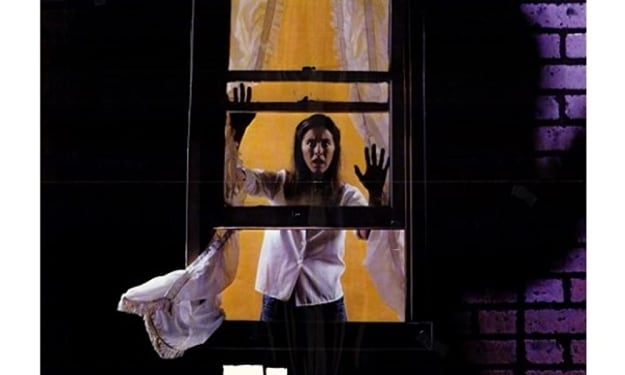Horror in the 90s: 'The Guardian'
William Friedkin's disastrous return to the horror genre, The Guardian is shockingly inept.

The Guardian (1990)
Directed by William Friedkin
Written by Stephen Volk, William Friedkin
Starring Dwier Brown, Carey Lowell, Jenny Seagrove
Release Date April 27th, 1990
Box Office $17,000,000
The Guardian stars Dwier Brown and Carey Lowell as Phil and Kate Sterling. Phil and Kate have just moved to Los Angeles and have just found out they are having their first baby. Exciting times continue as their two jobs afford them a lovely suburban home and the ability to hire a nanny to care for their baby. The nanny they end up with is Camilla, played by Jenny Seagrove. Camilla got the job after the woman they initially wanted disappeared.
We know that that woman, played in a cameo by the wonderful Teresa Randle, has been badly injured, or possibly killed in a bike accident. We see this but it’s never clear if Phil and Kate are aware of what happened. Regardless, they appear quite pleased with hiring Camilla who appears to be warm and caring and has good references that they choose not to look into because she appears so sweet and sincere. What Phil and Kate don’t know however, is that a baby Camilla cared for in her last job, went missing under suspicious circumstances.
This sounds vaguely like the plot of The Hand that Rocks the Cradle, doesn’t it. Indeed, The Guardian, at one point, was envisioned as a thriller along that line, one taking advantage of the fears of young parents. Then, at another point, The Guardian was envisioned as a broad horror comedy to be directed by Sam Raimi about a mystical being that cares for an ancient tree by providing the tree with the blood of babies. When Raimi left the project and was replaced by directing legend William Friedkin, the director of The Exorcist apparently decided to mash these two disparate premises together.
Thus we have The Guardian a horror-thriller about an evil enchanted tree protector who steals babies from unsuspecting couples to feed her evil enchanted tree. This sounds comic but it is not intended to be funny in any way. It is however, just as sloppy, slipshod, and silly, as such a mash-up of movies would inevitably be. Friedkin choosing to keep both movies that The Guardian used to be and trying to awkwardly weld them together ends up delivering a desperately confused and unintentionally funny horror mess.
The Guardian was William Friedkin’s return to the horror genre for the first time since The Exorcist. To say that Universal Pictures was excited to have the horror legend doing his first horror movie in 17 years for them, would be an understatement. The company kept their hands off of the project and let Friedkin have full creative control over the project only so that they could secure the credit, ‘From the director of The Exorcist,’ for their marketing campaign. Even as the writing was clearly on the wall that The Guardian was a boondoggle, the company was buoyed by Friedkin’s reputation.
That gamble appears to have paid off at the box office as the film didn’t cost much and grossed $17,000,000 dollars over its theatrical run. That would be around $40 million dollars today on a relatively low budget. Bottom line, the film was at least modestly profitable and that can mostly be attributed to the appeal of Friedkin. It makes sense that no one bothered to question his decision making, even as the movie was clearly a mess. Friedkin was a horror master whose return to the genre was going to be successful regardless of the movie.
How bad the movie ended up being may have been a bit surprising. In one example of the slipshod production, IMDB trivia tells us that a sequence near the end of the film that shows Seagrove’s Camilla having her leg exploded off of her body, is followed by a pair of scenes in which that same leg is fully intact. Little inconsistencies like this could be forgivable if the rest of the movie were any good but unfortunately, the rest of the movie is equally laughable.
Camilla has these vaguely defined, witch-like powers, which she only uses sparingly. She can control wolves, for some reason, and uses them to attack men who try to assault her in a forest and a man who may have caught on to her evil feeding babies to trees plan. That man is played by a desperately miscast Brad Hall, of Saturday Night Live fame. Hall is a comic performer who may have been suitable for a role in the horror comedy version of The Guardian but he’s desperately out of place in a serious version of The Guardian. His energy is purely comic awkwardness and he’s entirely at odds with the rest of the movie.
Camilla also flies in a scene that caused me to burst into laughter. It’s a great laugh. It’s one of those unexpectedly big laughs that shake your whole body. When she lifted into the air, I burst. It was so funny and so not intended to be funny. She never uses this particular talent again in the movie. It’s used just one time and it isn’t effective as there is still a whole other big horror set piece to close the film. That Camilla can fly is pointlessly employed for one scene and while I am glad it happened, it made me laugh so hard, it should not be in this movie.
In terms of odd, and deeply unnecessary tropes, sexual assault has a role to play in The Guardian. Camilla survives a sexual assault early in the movie when three hoodlums emerge from the woods and Camilla's magical tree comes to life to brutally murder her attackers, cutting off limbs, cutting one guy in two, and commanding wolves to eat the head of a third attacker. It’s bloody and violent but it’s also rushed and seems to exist solely to give the movie an excuse to be bloody. I will be polite and admit that the scene does also exist to show off the power of the tree but considering this power is only seen this one time, it renders the whole thing rather irrelevant.
Not long after this scene, Camilla sexually assaults Phil though it may have just been a dream. But no, it wasn’t a dream because the sex scene reveals a detail about Camilla that becomes important later in the movie. She has a scar on her body that is only seen in this sex scene, so the assault did happen, apparently, using her magical tree powers. Why? Who knows, apparently Friedkin wanted a sex scene. The scene does provide a detail for later but one that likely could have been imparted in another way.
Perhaps it could have been revealed in the scene where Camilla, having only just met the couple and became their nanny, bathes completely nude with their baby and Phil finds them. She makes no attempt to cover herself and appears to be tempting Phil into a sexual situation, something he takes far too long to extricate himself from. That scene is right before the sexual assault dream and could have easily provided the visual evidence needed later in the movie. Thus, both sexual assaults are gratuitous, and comically unnecessary.
Did I hate everything about The Guardian? No, not everything. The movie is bad but it contains elements of good filmmaking. I loved the makeup design late in the film. In the final act, Camilla’s identity as a baby pilfering tree protector is revealed and she morphs into a monster covered in tree bark but with the body of a swimsuit model. As the scene progresses, more and more bark appears on her body and it's a terrific bit of makeup and effects work. When her leg is destroyed, it splinters like a tree in spectacular fashion. That’s undone by the continuity error I mentioned earlier, but still, there is the germ of some good work in The Guardian.
Sadly, the whole of The Guardian is a mess. It’s yet another example of a production where the behind the scenes story is far better than the movie. How a movie that was once a thriller about a killer nanny became a Sam Raimi horror comedy and then became a hybrid of those two ideas, horrifically blended together in a Frankenstein’s monster of bad ideas, is quite a good Hollywood story. It has the mercenary elements of a marketing team being more important than the movie, Hollywood executives being dilettantes, and struggling screenwriters and actors desperately trying to make sense of the misshapen mess they are stranded within.
The Guardian is the latest entry in the serialization of my book project Horror in the 90s. I am writing about the movies, tropes, stars and filmmakers who made horror what it was in the 1990s. William Friedkin returning to the genre in 1990 should have been a watershed moment and instead it resulted in The Guardian. That’s something I want to expand on in the book but I can only do that with your help. You can help me make Horror in the 90s happen by making a monthly pledge or by leaving a one-time tip here on Vocal.
You can read previously serialized portions of the book on Horror.Media including pieces on Henry Portrait of a Serial Killer, The First Power, Frankenhooker, The Exorcist 3, Tales From the Dark Side The Movie, and many, many more. You can read many on my author page at Vocal, linked here. It’s a great way to get a sense of what I hope the final book will look like. You can help make the book a reality with your donation here on Vocal or via my Ko-Fi Account.
On Ko-Fi you can make a request for me to review the movie of your choice. For a $10 dollar donation, I will review the movie or your choice. I cannot promise the review will be a positive one, but I will make it as entertaining as I possibly can. All donations via Ko-Fi will go towards the completion of Horror in the 90s which will include nearly 200 movie reviews and pieces on the filmmakers, stars, and franchises that defined horror in the decade. It’s a comprehensive project but one that I am eager to take on and complete. Thanks!
About the Creator
Sean Patrick
Hello, my name is Sean Patrick He/Him, and I am a film critic and podcast host for the I Hate Critics Movie Review Podcast I am a voting member of the Critics Choice Association, the group behind the annual Critics Choice Awards.
Enjoyed the story? Support the Creator.
Subscribe for free to receive all their stories in your feed. You could also pledge your support or give them a one-off tip, letting them know you appreciate their work.






Comments
There are no comments for this story
Be the first to respond and start the conversation.